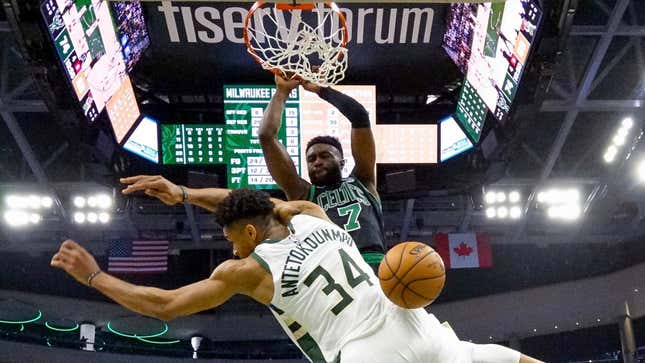
The major question coming out of Game 1 of the ballyhooed Celtics-Bucks series is how the Bucks plan to recover after having home-court advantage yanked away in a discouraging loss. The long and short of it is, the Bucks, from head coach Mike Budenholzer on down, do not feel that strategic adjustments are necessary—improved energy and focus and execution, certainly, but no tactical shifts are required:
ESPN’s Tim Bontemps found more of this line of thought in a story today, in particular from Giannis Antetokounmpo, who emphatically rejects the idea of making adjustments after he was roundly humiliated by Al Horford:
“Definitely not,” he said when asked whether the Bucks need to make big changes to their game plan to respond to how the Celtics played. “We’re just going to keep doing what we’ve been doing all year. I don’t think we should change at all. Why should there be a change after a game that we lost? We should not be the team that made the adjustment.
“We are going to come out and play our hardest and see how Game 2 goes. If it doesn’t go well for us, then you can think about adjusting. But right now, we are not adjusting nothing. We are just going to play. Be us. Go out there and compete.”
There’s definitely something to the idea that the Bucks need to do their regular shit better than they did it in Game 1. They were noticeably slow to get into their offense, and bland and predictable in their approach to getting Giannis pointed downhill in the paint against Boston’s disciplined defense. Time and again, Giannis tried to first-step his way past Horford, and ran into a sea of arms, and then tried to Euro-step his way through traffic, and wound up just stumbling his way into trouble. It wouldn’t be much of a strategic departure to, for example, put Giannis in the post instead of having him attack from the perimeter, so that Boston has fewer options for impeding his path to the paint. The basic Giannis-plus-shooters strategy that pushed Milwaukee to the best record in the league this season is a keeper, and the Bucks would be nuts to overhaul it now.
But it’s worth noting two things: first, the Bucks lost Game 1 by a whopping 22 points, and at no point in the second half did they look capable of bothering the Celtics at either end; and second, the Bucks already did make adjustments in this series. Giannis, for example, put up five three-point attempts in 34 minutes, nearly double his per-game average from the regular season. Khris Middleton, locked up and frustrated by Boston’s endless supply of long and athletic wing defenders, used fewer than a fifth of Bucks possessions during his minutes, a drop from weapon-level usage (24.4 percent) to that of a fourth or fifth option. Those possessions tilted instead toward the gruesome combination of Ersan Ilyasova (22 percent usage over 19 minutes) and Pat Connaughton (24 percent usage over 24 minutes), among other minimally qualified finishers. Brook Lopez took just four three-pointers in 26 minutes of run, over two fewer attempts than he averaged during the regular season.
What’s disturbing about the More Of The Same, But Better approach is less that the Bucks are stubborn about introducing wrinkles after such a one-sided loss and more that their reluctance could indicate a lack of wrinkles at the ready. Budenholzer ran a similar space-and-attack offense with the Atlanta Hawks, good enough to power a relatively unimpressive roster to a 60-win season in 2015 and the top seed in the Eastern Conference playoffs. Yes, their eventual playoff loss came in a sweep to LeBron James and the Cleveland Cavaliers, but that entire playoff run was marked by an ugly return to mortality, and their sixth-ranked offense dropped more than six points per hundred possessions in the postseason. A regular feature of Coach Bud’s time in Atlanta was playoff flameouts—his preferred offense is a regular season killer, but let’s just say this wouldn’t be the first time it dried up against a defense keyed in at playoff-intensity.
The unintended redistribution of shots in Milwaukee’s top-five regular-season offense is the result of Boston forcing them away from the things they want to do—get Giannis into the paint with a live dribble, and get Middleton cooking switch defenders on the perimeter—and into shit they’d prefer not to do, like really anything that involves Ilyasova. The point is, adjustments are made whether a team plans them or not. The Bucks have their work cut out for them, playing Game 2 without one of their most versatile floor-spacing guards against a team that appears to have their number. No one is looking for them to suddenly run the Stanford offense, but a few thoughtful adjustments seem a lot more likely to unglue Boston’s defense than just, uhh, trying harder. If stubbornness doesn’t make up the frankly huge gap exposed in Game 1, the Bucks stand a very good chance of having missed their last realistic opportunity to try anything else.